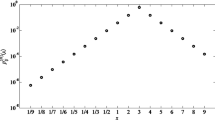Abstract
In a group decision making process, several individuals or a committee have the responsibility to choose the best alternative from a set. The problem addressed in this paper is how to aggregate personal preferences to arrive at an optimal group decision. New technologies allow individuals that may seldom or never meet to make group decisions. This paper proposes a methodology to obtain the group preference ordering in two steps. Firstly, each individual studies the problem isolated, and then, in a possibly virtual meeting, the group must agree on the preferences on some pairs of alternatives. Then, the group criterion is achieved by using a logistic regression model within the pairwise comparison framework proposed here. Properties of the procedure are studied and two illustrative examples are presented.
Similar content being viewed by others
References
Agresti A (1996) An introduction to categorical data analysis. Wiley
Arrow KJ (1951) Social choice and individual values. Wiley
Freeman DH (1987) Applied categorical data analysis. Marcel Dekker
French S (2003) The challenges in extending the MCDA paradigm to e-democracy. J Multi-Criteria Decision Anal 12:63–233
French S (2006) Web-enabled strategic GDSS, e-democracy, and Arrow’s theorem: a Bayesian perspective. Decision support systems (to appear)
Jacquet-Lagrèze E, Siskos Y (1982) Assessing a set of additive utility functions for multicriteria decision making: the uta method. Eur J Operat Res 10(2):151–164
Keeney RL, Raiffa H (1976) Decisions with multiple objectives: preferences and value tradeoffs. Wiley
Kelly FS (1978) Arrow impossibility theorems. Academic Press, New York
McCullagh P, Nelder JA (1989) Generalized lineal models, monographs on statistics and applied probability. Chapman & Hall
Perduzzi P, Concato J, Kemper E, Holford TR, Feinstein AR (1996) A simulation study of the number of events per variable in logistic regression analysis. J Clin Epidemiol 49:1373–1379
Pirlot M (1996) General local search methods. Eur J Operat Res 92:493–511
Ryan TP (1997) Modern regression methods. Wiley
Ríos Insua D, Holgado J, Moreno R (2003) Multicriteria e-negotiation systems for e-democracy. J␣Multi-Criteria Decision Anal 12(2–3):213–218
Saaty TL (1980) The analytic hierarchy process. McGraw-Hill
Acknowledgments
The authors would like to thank the reviewers for comments and suggestions which have highly improved not only the readability of the paper but also its content. This research was partially supported by Ministerio de Educación y Ciencia, Spain (Project TSI2004-06801-C04-03) and the European Science Foundation (Towards Electronic Democracy program).
Author information
Authors and Affiliations
Corresponding author
Appendix. Logistic regression model
Appendix. Logistic regression model
This appendix introduces the notation and uses of the logistic regression model. Logistic regression is part of a category of statistical models called Generalized Linear Models (GLM). Excellent treatments of GLMs are presented, for example, in Agresti (1996) and Ryan (1997).
Binary logistic regression is a variation of ordinary regression, useful when the dependent variable Y is restricted to two values, which usually represent the occurrence (coded as 1) or non-occurrence (coded as 0) of some outcome event. It produces a formula that predicts the probability of the event occurrence π as a function of independent variables X 1,X 2,...,X n . The independent or predictor variables can take any form (continuous, discrete, dichotomous,...) and no assumption is necessary about their distribution. The expression for π is given by
Rights and permissions
About this article
Cite this article
Arias-Nicolás, J.P., Pérez, C.J. & Martín, J. A logistic regression-based pairwise comparison method to aggregate preferences. Group Decis Negot 17, 237–247 (2008). https://doi.org/10.1007/s10726-007-9071-0
Published:
Issue Date:
DOI: https://doi.org/10.1007/s10726-007-9071-0




